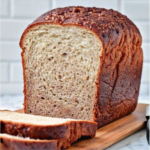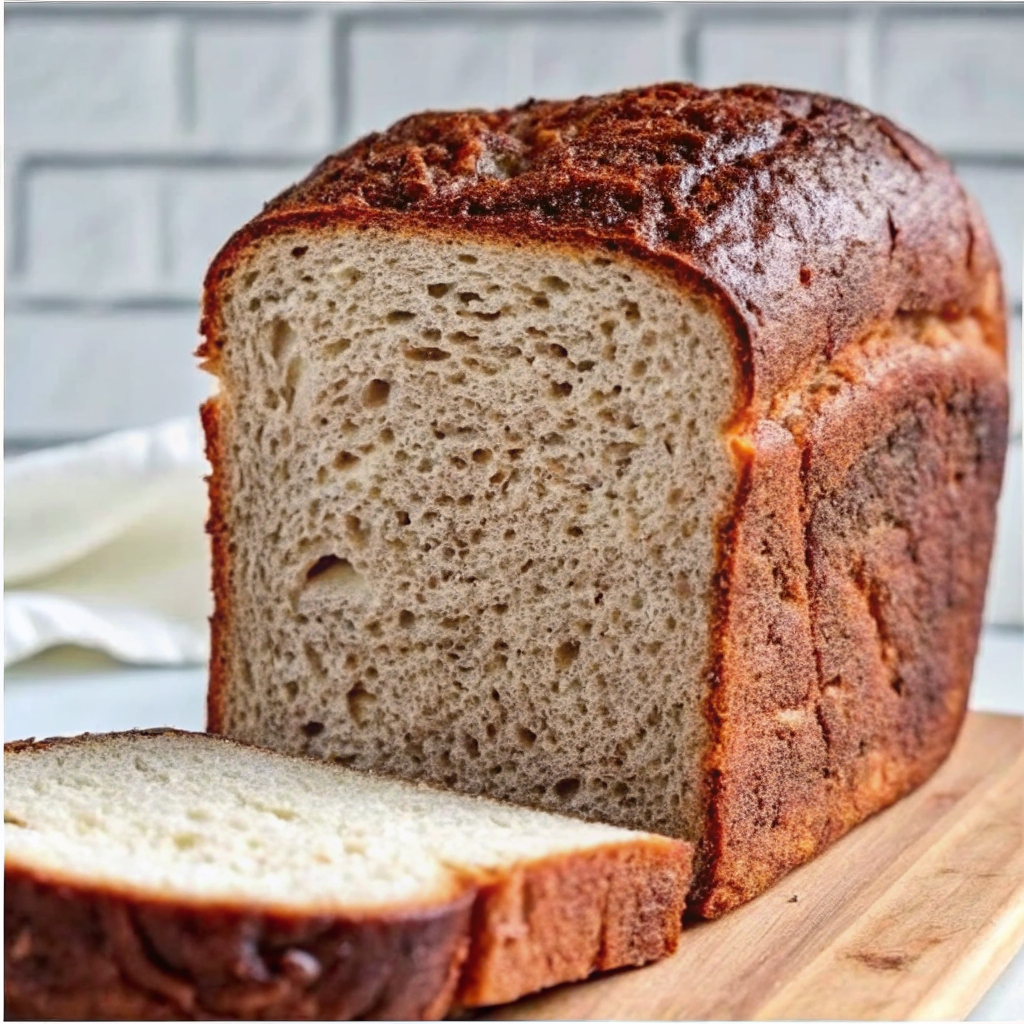Introduction
Making gluten-free sourdough sandwich bread from scratch is a rewarding experience, especially when you’re able to create a fluffy and delicious loaf without any gluten. This recipe combines whole milk (or dairy-free milk) with gluten-free flour to make a soft, airy sandwich bread that boasts a slightly tangy flavor from the addition of a sourdough starter. Whether you have gluten intolerance or you’re simply looking for an alternative to traditional bread, this recipe will help you make a delightful loaf perfect for sandwiches.
Let’s dive into the ingredients and the step-by-step instructions for baking this gluten-free sourdough bread.
Table of Content
Table of Contents
Ingredients for Gluten-Free Sourdough Sandwich Bread
Before getting started, make sure you have the following ingredients on hand:
- 650 grams whole milk (dairy-free milk may be substituted)
- 56 grams of butter, melted (dairy-free butter may be substituted)
- 10 grams of whole psyllium husks (or one tablespoon of psyllium husk powder)
- 29 grams of granulated sugar
- 100 grams gluten-free sourdough starter (active and bubbly – see Notes)
- 400 grams Kim’s gluten free bread flour blend
- 12 grams of kosher salt
- 8 grams of baking powder
For Brushing:
- 28 grams butter, melted for brushing
These ingredients will come together to form a wonderfully soft, gluten-free sourdough sandwich bread that can be used for everything from hearty sandwiches to delicious toast.
Preparing the Dough for Gluten-Free Sourdough Sandwich Bread
Start by following the steps below to prepare the dough for your gluten-free sourdough bread:
- Weigh the Ingredients:
- Weigh out all the ingredients into the bowl of a stand mixer (or a large mixing bowl). It’s important to follow the order of the ingredients listed above to ensure proper mixing. This provides the right texture and consistency in the dough.
- Mix and Knead the Dough:
- Using either the dough hook or beater blade of the stand mixer, mix and knead the dough on medium speed for 5 minutes. If you don’t have a stand mixer, you can also knead by hand, but a stand mixer will make the process much easier.
- Proof the Dough:
- Scrape the dough into the center of the bowl, cover it, and let it proof until it doubles in size. This process could take anywhere from 6 to 8 hours, or you could leave it overnight. Patience is key in this stage, as the dough needs time to ferment properly.

Gluten-Free Sourdough Sandwich Bread
- Total Time: 8 hours 15 minutes (including proofing)
- Yield: 1 loaf 1x
Description
This Gluten-Free Sourdough Sandwich Bread is soft, tangy, and perfect for sandwiches. Made with a gluten-free starter, it’s an easy way to enjoy sourdough without the gluten!
Ingredients
- 650 grams whole milk (dairy-free milk may be substituted)
- 56 grams butter, melted (dairy-free butter may be substituted)
- 10 grams whole psyllium husks (or 1 tablespoon psyllium husk powder)
- 29 grams granulated sugar
- 100 grams gluten-free sourdough starter (active and bubbly)
- 400 grams gluten-free bread flour blend
- 12 grams kosher salt
- 8 grams baking powder
- 28 grams butter, melted for brushing
Instructions
- Prepare the Dough: In the bowl of a stand mixer, add the ingredients in the listed order. Mix with a dough hook or beater blade on medium speed for 5 minutes until the dough is smooth but slightly sticky.
- Proof the Dough: Scrape the dough into the center of the bowl, cover it, and let it proof for 6-8 hours or overnight. The dough should double in size.
- Shape the Dough: Once proofed, turn the dough onto a floured surface and knead it to remove air bubbles. Grease an 8.5 by 4-inch Pullman loaf pan, shape the dough into a loaf, and place it in the pan. Let it rise again until it reaches the top of the pan (3-6 hours).
- Bake the Bread: Preheat the oven to 450°F. Score the top of the dough, brush with melted butter, cover the loaf with an inverted pan, and bake for 15 minutes. Then reduce the temperature to 375°F and bake for another 45-60 minutes, or until the internal temperature reaches 210°F.
- Cool and Slice: Remove the bread from the pan and cool it on a wire rack. Let it cool completely before slicing to avoid gummy slices.
Notes
For best results, refrigerate the dough overnight for easier handling. Allow the bread to cool completely before slicing to achieve the perfect texture.
- Prep Time: 15 minutes
- Cook Time: 1 hour
- Category: Bread
- Method: Baking
- Cuisine: American
Nutrition
- Serving Size: 1 slice
- Calories: 120
- Sugar: 2g
- Sodium: 200mg
- Fat: 5g
- Saturated Fat: 2g
- Unsaturated Fat: 3g
- Trans Fat: 0g
- Carbohydrates: 15g
- Fiber: 2g
- Protein: 3g
- Cholesterol: 10mg
Hand-Kneading and Refrigerating:
If you plan to hand-knead and shape the dough, it’s recommended to refrigerate it for at least 5-6 hours, preferably overnight. This will prevent the dough from being too sticky when you try to shape it.
Is Traditional Sourdough Bread Gluten-Free?
A common question for those avoiding gluten is whether sourdough bread can be considered a safe option. Despite its fermentation process, traditional sourdough bread is not gluten-free. Let’s break down why this is the case:
Why Traditional Sourdough Contains Gluten
Traditional sourdough bread is made with wheat flour, which contains gluten. Although the fermentation process can reduce the gluten content slightly, it does not remove it entirely. As a result, sourdough made from wheat flour still contains enough gluten to cause reactions in individuals with celiac disease or gluten sensitivity. While the fermentation process can sometimes make sourdough easier to digest for some, it’s still not gluten-free and should be avoided by anyone needing to eliminate gluten.
Can Sourdough Cause Issues for Those with Gluten Intolerance?
Yes, even though sourdough is fermented, it can still trigger gluten intolerance in individuals with gluten intolerance. For those with gluten sensitivity or celiac disease, consuming traditional sourdough can lead to digestive issues and other health concerns. Anyone with gluten intolerance needs to choose breads that are explicitly made without gluten-containing ingredients.
To enjoy a sourdough-like experience safely, those who need to avoid gluten should opt for gluten-free sourdough bread, which is made with gluten-free flour and a specially crafted starter. In the following section, we will explain how gluten-free sourdough bread is made and how it differs from traditional sourdough bread.

Baking the Gluten-Free Sourdough Sandwich Bread
After the dough is shaped and stabilized, it’s time to bake:
- Preheat the Oven:
- Preheat your oven to 450°F and move the rack to the lowest setting to ensure even heat distribution.
- Score the Bread:
- Once the dough is fully proofed, remove the plastic wrap. Use a bread lame (or a sharp serrated knife) to score the top of the bread. Scoring helps the bread rise evenly and gives it a rustic, attractive appearance.
- Brush with Melted Butter:
- Gently brush the top of the bread with the melted butter for a golden, shiny finish.
- Bake with Cover:
- Cover the loaf with an inverted pan of equal size to trap the heat. Bake for 15 minutes at 450°F, then remove the inverted pan and reduce the temperature to 375°F. Continue baking for another 45-60 minutes, or until the loaf feels light for its size and a thermometer inserted into the center reads at least 210°F.
- Prevent Over-Browning:
- If the top of the loaf is browning too quickly, loosely cover it with foil to prevent burning.
- PART 5: Cooling and Storing the Gluten-Free Sourdough Sandwich Bread
- After baking, it’s crucial to let the gluten-free sourdough sandwich bread cool properly to maintain its texture and flavor. Here’s how to handle the cooling and storage process:
- Remove the Bread from the Pan:
- Once the bread is baked to perfection, immediately turn it out of the loaf pan and place it onto a wire rack. This helps the bread cool evenly and prevents any trapped moisture from making it soggy.
- Brush with Butter:
- For added flavor and a beautiful glossy finish, brush any remaining melted butter over the entire loaf. This step enhances both the taste and appearance of the bread.
- Let it Cool Completely:
- Patience is key! Allow the bread to cool completely before slicing it. If you slice it too soon, the bread may become gummy and fail to hold its shape well. It’s best to wait until the bread has cooled to room temperature to ensure perfectly sliced bread.
- By following these steps, you’ll preserve the freshness and texture of your gluten-free sourdough sandwich bread. Enjoy it at its best once fully cooled.
for more recipe Facebook and Pinterest
Frequently Asked Questions (FAQs) About Gluten-Free Sourdough Bread
Is any sourdough bread gluten-free?
No, traditional sourdough bread is not gluten-free. While sourdough undergoes fermentation, which can break down some of the gluten, it still contains enough gluten to trigger reactions in people with celiac disease or gluten intolerance. Therefore, it’s important to look for a specifically labeled gluten-free sourdough bread if you need to avoid gluten.
Does sourdough trigger gluten intolerance?
Yes, traditional sourdough bread can trigger gluten intolerance. Despite the fermentation process, the gluten content in traditional sourdough bread remains too high for individuals with gluten sensitivity or celiac disease. If you are gluten-sensitive, it is crucial to avoid sourdough unless it is made with gluten-free ingredients. A gluten-free sourdough starter should be used for making bread that is safe for those with gluten intolerance.
Is gluten-free sourdough bread possible?
Yes, gluten-free sourdough bread is absolutely possible! It requires a bit more effort than regular sourdough bread because gluten-free flours do not have the same structure as wheat-based flour. However, using ingredients like gluten-free flour blends, psyllium husks, and a gluten-free sourdough starter can create a successful and tasty loaf. The bread will have a similar texture and flavor to traditional sourdough but without the gluten.
Can you eat sourdough bread if you are gluten-free?
If you are following a gluten-free diet due to celiac disease or gluten sensitivity, you should not eat traditional sourdough bread. However, you can enjoy gluten-free sourdough bread, which is made with gluten-free ingredients and a gluten-free sourdough starter. This version is safe and provides a similar tangy flavor and airy texture to traditional sourdough bread, but without the gluten.
Conclusion
In this article, we’ve explored everything you need to know about gluten-free sourdough sandwich bread, from the ingredients to the step-by-step instructions for making it at home. You’ve learned about the unique qualities of gluten-free sourdough, how it compares to traditional sourdough bread, and why it’s a fantastic option for those with gluten intolerance or celiac disease.
Not only does this bread offer a delicious, slightly tangy flavor, but it’s also perfect for sandwiches or simply enjoying on its own with a bit of butter. Whether you’re a seasoned baker or new to gluten-free baking, this recipe will give you the knowledge and confidence to bake your own gluten-free sourdough bread at home. Enjoy baking, and happy eating
